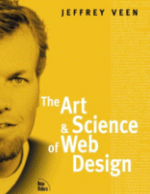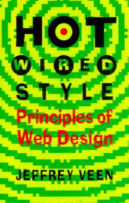A Conversation With Jeffrey Veen
by Claire E. White
Jeffrey Veen is an internationally sought-after speaker, author and consultant. He is a founding partner of Adaptive Path, the highly regarded consulting group, which focuses on the impact of design on business.

|
He is known for his incisive analytical abilities, innovative ideas, no-nonsense approach, and his ability to make even the most abstruse web design and technical subjects easily accessible to the everyday reader.
Jeffrey previously worked as the managing editor and creative director of South Coast Community Newspapers, and has been active in the Internet community since 1987. He is a graduate of Calvin College in Grand Rapids, Michigan, and lives in San Francisco with his wife, Leslie.
Jeff spoke with us about his new book, The Art & Science of Web Design, the future of print, and what writers and journalists can do to make themselves more marketable in a down economy.
How did the idea for this book come about?
 Click here for ordering information. |
What are the biggest mistakes in web design that you see?
After all this time on the Web, we all still get enamored with sexy technology and forget why we're actually building websites. I see so many corporate sites that still try to be "cool" when all their users want is to accomplish a simple task. This may be a problem we never solve, unfortunately.
When a company comes to you as a consultant for Adaptive Path wanting to know how to improve its website, how do you approach the analysis? Let's assume it's for an ecommerce site which sells several products.
It's a relatively straightforward process of understanding the site's
| "Some sites are capable of providing both free and paid content -- the Economist.com site is a good example -- but again it's because their content is so desirable to a particular audience. I really don't think this will be a wide-spread model for content on the Web in the future." |
Then, we try to infuse some iteration into their process. So many websites use a linear process for developing their products. It's like a hot potato being tossed from department to department -- first marketing, then design, then production, then engineering. But none of these people are talking to each other or learning from one another. Rather, we try to get them to go through this loop many times in the lifecycle of a product. One way to sort of enforce this is by scheduling user tests at regular intervals. That way, there are milestones in the process we have to hit: we've got to get the first prototype ready in three weeks because there are users coming in to test it then. Works pretty well.
I'd like to talk a bit about the new IAB ad standards. What is your opinion of the new, larger ad sizes, such as those used on CNET's News.com?
They will be effective in the short term, and then drop right down to where traditional ad banners are now. It's just a gimmick, frankly, and while they may be able to get a few more clicks from a few users, they ultimately won't engage any additional traffic.
Unfortunately, most advertisers still think that the size or "interactivity" of their ad units has something to do with how well they will perform. That's just not the case. The problem comes from trying to insert a commercial message into a focused user task. Think about the experience: you log on to a website to, say, check the weather. What are the odds that three clicks into that process you'll decide to follow a banner selling you a car? Of course not. You want the weather forecast, and it's a safe bet you'll get that weather forecast and completely ignore the ads. Advertising does work, but only when the context matches the user's goals.
And, by the way, putting up a fake error message and telling me my "Internet connection is not optimized" in attempt to trick me into clicking is just stupid.
Traditionally, there has been a lot of resistance on the part of web publishers to allow rich media ads on their sites, citing the high implementation costs, large use of bandwidth, and customer hostility (especially to interstitials and superstitials). Are rich media ads here to stay? Are they worth the money to the corporations who pay to develop them?
I can't imagine they're here to stay. It's just an elaborate and desperate attempt to get a few more clicks. I don't want deep interaction with a sliver of the page. And I certainly don't want audio streaming out of an advertisement.
I've already mentioned that advertising has to be consistent with the user experience. But that user experience goes deeper than just a user's goals on a particular site. It also encompasses things like the performance of a site. Web publishers have resisted complicated rich media ads because they will slow a site down, and that's the last thing you want to do. There are implications for the site's usability, as well. And none of these things are worth risking for the short term revenue of a rich media ad campaign.
Lately there has been much debate about the advertising-supported free content sites (say, USA Today) vs. subscription content sites (WSJ.com). Salon.com has recently offered a subscription premium service which promises to be ad-free. Will people pay for content on the Web, other than for porn or financial news? Is it a workable solution to provide two levels of content (subscription and non-subscription) on one site?
I call this the Disneyland Effect. If an experience is compelling enough,
| "Unfortunately, most advertisers still think that the size or 'interactivity' of their ad units has something to do with how well they will perform. That's just not the case." |
Some sites are capable of providing both free and paid content -- the Economist.com site is a good example -- but again it's because their content is so desirable to a particular audience. I really don't think this will be a wide-spread model for content on the Web in the future.
I'd like to talk about the actual writing process for the book. When you write, do you keep a set schedule? What kind of surroundings do you have when you write?
I wrote this book in the bits and pieces of spare time I could find amidst a hectic travel and speaking schedule and a full time job. I often found myself half asleep in front of the computer at 6:00 am, or squeezing out a chapter on a cross-country flight. It's not a method I recommend, as the book took me two years to write -- a year longer than I had thought.
One technique I did find valuable was writing by using email. I would send messages to my editor about what I was thinking of writing, and he would write back with a couple suggestions or questions, and I would write a big long response and eventually I'd have emailed myself into the bulk of a new chapter.
One of the most irritating and time-consuming things for a web team is designing a site so that it will work in many different browsers. The book has a fascinating description of how the situation developed the way it has. Is there any hope on the horizon for a set of cross-platform standards any time soon?
 Click here for ordering information. |
But still today, we're mired in the mess the browser vendors gave us. It's totally ridiculous that Web developers have been caught in the middle and have to keep track of what works in each browser. What a waste of resources. And with end users, the situation seems even crazier. Who cares what browser is installed on your machine? Can you imagine having to upgrade to the latest NTSC color space just to watch the next installment of "ER"? Of course not.
Your book takes an unusual and innovative approach: instead of pages of code samples and examples, you take a more "holistic" approach towards teaching the fundamentals of web design. What's the first thing that a webmaster can do to learn to "think" more like a good web designer?
Learn why the Web works the way it does. I talk in the book about the print designers I worked with at Wired Magazine. They were amazing in their knowledge of not only the design process, but the print process. They could tell you more than you'd ever want to know about how inks interact with one another, how paper absorbed them, how different types of light reflected off them ... and on and on. It made them better designers.
That's why I'm astounded by designers on the Web who feel that HTML is too limiting for their creatively. Granted, HTML is primitive when compared to the typographic and visual design capabilities of even the simplest desktop publishing program. But it's also a universal format for displaying information globally. By understanding those limitations and capabilities and exploiting both is the key to becoming a good Web designer.
Your chapter on Speed was quite interesting. Every one knows that a slow-loading webpage is irritating, but you state that slow-loading webpages (especially on large sites) actually cost site owners a lot of money. Why is that?
Well, first there is the user experience. No matter how well designed and usable your site may be, if nobody waits around for it to download, it will be wasted. Speed is the most important factor in the success of any site. Make a slow site, and people won't use it. It's as simple as that.
But there is a purely financial aspect to it, as well. Bandwidth costs money -- money that comes out of your bottom line as a company. I was once talking to a CTO of a very large website who explained that they had done a cost analysis of their bandwidth. They found that with the amount of traffic they had, they were spending 16 cents per month per character in their HTML source code. So it made good financial sense to pare down as much as they possibly could.
One of the problems in many large corporations is the total separation of the graphic artists, the programmers, editorial staff and corporate management; they seem to work in different, isolated environments, although they may all be contributing to the same website. What are the dangers of a corporate environment which is set up in this way, and how can companies avoid some of these problems?
Too many corporate websites suffer from "Org Chart Interfaces" -- where
| "No matter how well designed and usable your site may be, if nobody waits around for it to download, it will be wasted. Speed is the most important factor in the success of any site. Make a slow site, and people won't use it. It's as simple as that." |
I take development teams through a process of intimately understanding who their users are. We start with the demographics from the marketing department. So we learn that the target audience is 18-34 year olds who make a certain amount of money and enjoy a set of activities. That's fine, but we don't actually know anyone like that. The average couple in the United States has 2.3 children, but I don't know anyone with 2.3 children. So we need to get very specific and generate personas based on those demographics. We name these fictional users, give them jobs and hobbies and decide what kind of computer and net connection they would have. Then we design features for a website based on those scenarios. It's a much more effective process.
Many freelancers and journalists are being required to have some skill with HTML. What is your advice to the experienced journalist who doesn't know anything about programming or HTML? How can he or she get up to speed to become more marketable?
Spend an afternoon learning it. It's easy. Really. View the source of your favorite websites and see what code they're using to create the effects you like. As I said before, understanding the technology from the inside will give you an edge in what ever you do. Understanding the principles of coding will also help you have conversations with people outside your realm of expertise. It comes back to understanding the capabilities and limitations of the technologies that surround us every day.
I'm going to ask you to look 10 years into the future. Have paper books and magazines been replaced with electronic versions? How has the Internet changed from the way it is today?
Oh, I don't think we'll lose the paper-based media in a decade. They will get a lot more specialized, though. They'll be more focused on what they do well. For example, the popularization of television pretty much killed radio drama. Radio adapted and focused on news and music, leaving drama to a visual medium that suited it.
In 10 years, though, we'll be using the Internet much, much more but realizing it much, much less. For example, I have a box called a television that digitally records shows for me to watch later. It's a joy to use and has completely changed the way I consume that medium. And it's connected to the Internet for download program data and uploading my preferences. It's nothing like reading email or surfing the Web, but I'm certainly using the Internet. Similarly, most everything we do will slowly start to be transformed by Net-based technologies. Our commute to work will probably be transformed, as will the ways we entertain ourselves. But I think the technology will adapt to the things we already do in subtle ways, rather than the earth-shattering paradigm shifts the media likes to tout.
 |
Ten years ago, virtually nobody had email. Today we can't live without it. Ten years from now, there will be things we can't imagine integrated into our lives. I can't wait.
Return to the May 2001 issue of The IWJ.
More from Writers Write
